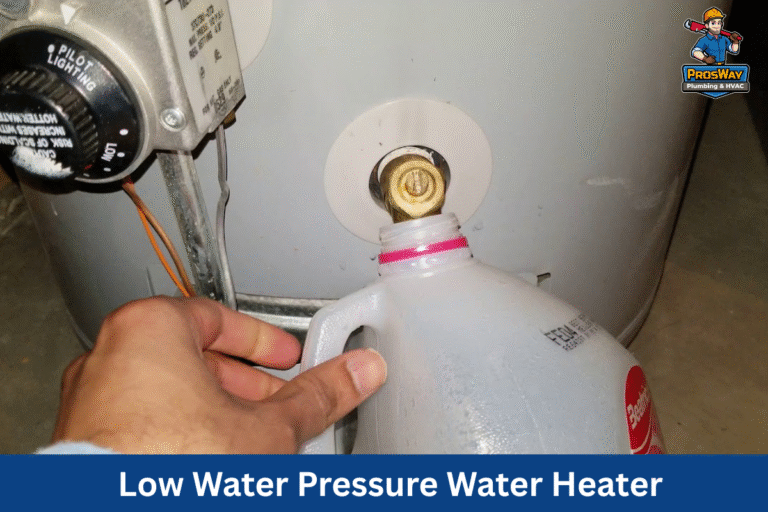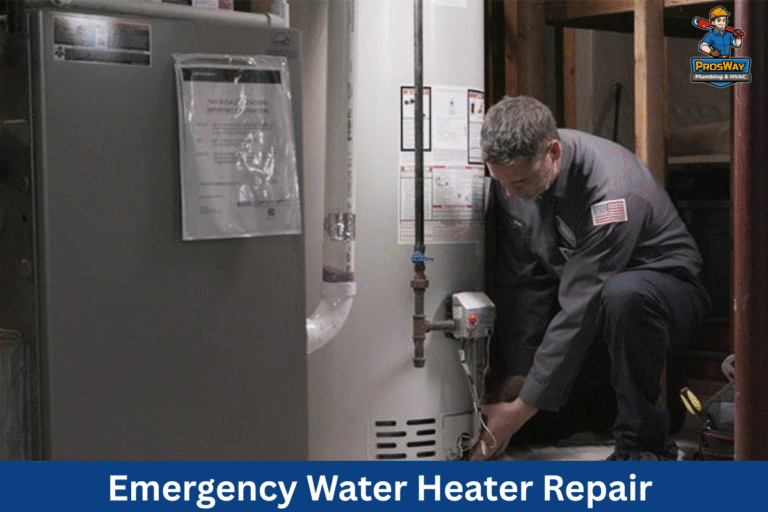How to kill tree roots in sewer line? The answer: act early, use the right methods, and follow up with prevention. Tree roots can find their way into sewer lines through small cracks, but with the right approach, you can stop the problem and keep it from coming back.
At ProsWay Plumbing & HVAC, we help homeowners across Northern New Jersey safely remove roots, restore proper flow, and protect pipes from future damage. This guide explains what works, what doesn’t, and when to call a professional.
Key Takeaways:
- Tree roots enter sewer lines through cracks or loose joints in search of moisture.
- Common signs of root intrusion include slow drains, gurgling toilets, sewer odors, and soggy lawn patches.
- Foaming root killers are the most effective chemical treatment as they coat the entire pipe interior.
- Copper sulfate and rock salt may work on small roots but aren’t reliable for major blockages.
- Mechanical methods like rooter machines and hydro jetting are needed for thick or fully blocked roots.
- Replacing damaged pipes with PVC offers a long-term solution against future root intrusion.
- DIY methods like vinegar and boiling water do not kill roots and can delay proper treatment.
- Annual camera inspections help detect root problems early, before they become expensive.
Why Tree Roots Invade Sewer Lines?
Roots grow toward moisture. Cracked, aging sewer pipes release vapor into the soil. Tree roots detect this moisture and grow toward the source.
Once roots find a pipe joint or small crack, they force their way inside. Over time, they spread through the pipe, causing blockages, broken joints, and full system failures.
According to the Environmental Protection Agency (EPA), root intrusion is one of the leading causes of sewer backups in residential systems, especially in homes over 30 years old. Clay and cast iron pipes are most at risk.
Tree roots don’t stop growing once they enter the pipe. They multiply and thicken until water can no longer pass through. If left untreated, roots in drain pipes can lead to full pipe collapse. Below is everything about tree roots and sewer lines.
How to Know If Roots Are Blocking Your Sewer Line?
Roots in sewer lines often go unnoticed until they cause real damage. By the time water stops flowing, roots may already be spread deep inside your pipes. Early detection can help you avoid major repairs.
Common Signs of Root Intrusion:
- Slow drains: One of the first signs that roots in pipes are blocking the flow.
- Gurgling sounds: Air trapped by root clumps creates noise when water drains.
- Frequent clogs: Recurring toilet backups can signal root growth in the main line.
- Sewer odor: Root-caused cracks let sewage gas escape into your yard or home.
- Soggy lawn: Roots force water out of broken pipe joints, creating wet spots or dips in the yard.
If you see any of these signs, call a licensed plumber. At ProsWay Plumbing & HVAC, we use sewer camera inspections to confirm if roots are the problem. A small waterproof camera shows the exact location and severity of the root intrusion.
No guesswork. No unnecessary digging. Once confirmed, the next step is deciding how to remove the roots safely and effectively.
How to Kill Tree Roots in Sewer Line?
The right solution depends on the size of the root blockage and the condition of your pipes. There are two main ways to kill roots in the sewer line: chemical treatment and mechanical removal.
1. Chemical Root Killers
These products are designed to kill tree roots in sewer lines without harming the entire tree. They target roots inside the pipe and stop regrowth.
Types of chemical root killers:
- Foaming Root Killers (Dichlobenil-based): These expand when mixed with water and cling to the full inner surface of the pipe, making them ideal for longer sections affected by roots. The foam penetrates root masses, kills the roots, and leaves behind a chemical barrier to prevent regrowth.
- Copper Sulfate Crystals: These dry out the root tips by removing moisture. The crystals settle at the bottom of the pipe and work well for minor root intrusion or as a maintenance treatment. They are less effective if the roots are widespread or clinging to pipe walls.
- Herbicidal Treatments (Metam Sodium, Dichlobenil): These are stronger formulas, typically used in municipal systems or larger commercial applications. They are effective but need careful handling and professional application.
According to the Water Research Foundation, foaming root killers are more effective than crystals because they treat the entire pipe circumference, not just the bottom. Watch this video to learn if root killers actually work:
Table: Comparison of Root Killers
| Method | Ingredients | Use Case | Time to Act |
| Copper Sulfate | Copper sulfate | Minor root presence | 3–7 days |
| Foaming Root Killer | Dichlobenil | Coats full pipe | 2–14 days |
| Metam Sodium | Herbicidal agent | Industrial/commercial settings | Varies |
Chemicals do not dissolve tree roots instantly. They kill roots over time. Once roots die, water flow pushes the dead material out gradually.
2. Mechanical Root Removal
When tree roots form large blockages, chemical treatments alone aren’t enough. Here comes the question: how to get rid of tree roots in sewer line. Mechanical methods physically remove the roots from the pipe to restore flow before any chemical treatment is applied.
Common mechanical root removal methods:
- Rooter Machine: This tool uses a motorized cable with a cutting blade that spins and slices through root masses. It’s ideal for tight blockages and older pipes with heavy root growth. However, it may not remove all root debris from the pipe walls.
- Hydro Jetting: A high-pressure water stream blasts away roots, grease, and debris. It’s thorough, safe for most pipe types, and clears the pipe wall completely. Hydro jetting is often paired with foaming root killer to prevent future growth.
- Pipe Replacement with PVC: If the roots have severely damaged the pipe or if it has collapsed, the only lasting solution is to replace it. PVC (polyvinyl chloride) pipes are resistant to root intrusion because they have tightly sealed joints and are not prone to cracking like clay or cast iron. This is a permanent fix for repeated root problems in the same location.
Can DIY Methods Kill Roots Effectively?

Many homeowners try DIY methods before calling a plumber. Some common at-home solutions include pouring vinegar, baking soda, rock salt, or boiling water into drains. While these may seem safe and low-cost, most are ineffective against established tree roots in sewer lines.
Let’s break down the facts:
- Vinegar and baking soda do not affect roots. These are better suited for minor clogs caused by grease or soap, not roots in drain pipes.
- Rock salt can dry out minor root growth, but it must be used repeatedly and in large amounts. Overuse may corrode cast iron or metal pipes.
- Boiling water has no ability to kill or damage tree roots. It may also crack old or weakened pipes if poured in large quantities.
According to plumbing industry data from NASSCO (National Association of Sewer Service Companies), DIY methods rarely reach deep enough into the main line to make a difference.
They may delay proper treatment, which gives the roots time to grow thicker and cause more damage. If you’re dealing with roots in sewer lines, it’s best to use proven methods, like foaming root killers or mechanical removal, followed by a maintenance plan to keep roots from growing in sewer lines again.
How to Clear Roots from Drain Pipes Safely?
When roots in drain pipes are left untreated, they can lead to full blockages, burst pipes, and raw sewage backups. Clearing them safely and correctly is essential for preventing long-term damage.
Follow these steps for safe removal:
- Schedule a camera inspection: A sewer camera pinpoints exactly where the roots are growing. It also shows how severe the blockage is. This helps avoid guesswork and unnecessary digging.
- Use mechanical removal if pipes are blocked: If flow is reduced or blocked, begin with hydro jetting or a rooter machine. These methods physically remove the roots from inside the pipe.
- Apply a chemical root killer after clearing: After the roots are removed, apply a foaming root killer to kill roots in the sewer line that may remain on the pipe walls.
This also prevents regrowth. - Avoid repeated chemical use without inspection: Misuse can damage pipes or harm nearby soil and plants. Only apply chemicals when pipes are confirmed intact.
- Replace damaged sections if necessary: If your pipe is cracked or collapsed, replace it with PVC to eliminate the chance of future root entry.
How to Keep Roots from Growing in Sewer Lines?

Killing roots once is not enough. Without prevention, they will return. Proper maintenance keeps your sewer line clear and working long-term. Ways to prevent root regrowth:
- Apply foaming root killer every 6–12 months. This helps stop new root growth inside the pipe. It works best after mechanical cleaning or as an annual treatment.
- Avoid planting trees near sewer lines. Keep tree roots at least 10 feet away from your sewer lateral. Avoid trees with aggressive roots, such as willows, maples, and sycamores.
- Schedule annual sewer inspections because early detection prevents major issues. A camera inspection can spot roots in sewer lines before they cause damage.
- Replace old or cracked pipes as old clay or cast iron pipes often allow roots in. Replacing them with PVC pipes eliminates entry points and resists intrusion.
Taking these steps helps keep roots from growing in sewer lines and reduces future repair costs.
Final Thoughts
Knowing how to kill tree roots in sewer line systems requires more than a single approach. The most effective results come from combining early detection, the right removal method, and long-term prevention. Mechanical removal is key when roots are thick and blocking water flow. Chemical root killers play a key role in stopping regrowth once the line is clear. Replacing the pipe with PVC helps prevent future intrusion if it is cracked or damaged.
Act Before Roots Damage Your Sewer Line!
If you’ve noticed slow drains, frequent clogs, or sewage odors in your yard, don’t ignore the warning signs. Call ProsWay Plumbing & HVAC for fast, professional solutions across Northern New Jersey. Our team offers sewer camera inspections, rooter and hydro jetting services, and safe root killer treatments designed to clear your pipes and keep them clear. Call us now at (862) 260-5870 or Book Online today for a personalized quote!








